FORMULAIC EXPRESSIONS
16 虚拟语气
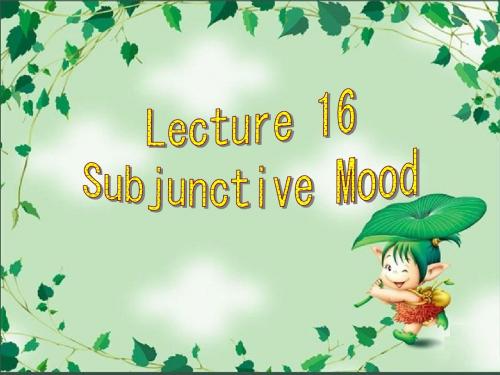
1. BE - subjunctive
The be-subjunctive is realized by the base form of the verb. [(should)+V原】 Whatever the person of the subject, the predicator invariably takes the base form.
1) In certain adverbial clauses
The be-subjunctive is also used in adverbial clauses introduced by if, though, whatever, so long as, whether, lest. If that be the official view, it cannot be accepted. If any person be found guilty, he shall have the right of appeal . Notes: This is limited to formal style, while in informal style the indicative mood or "should / may + infinitive" are used instead. If the rumour is true, everything is possible. He ran away lest he should be seen.
B. After such adjectives as advisable, appropriate,
desirable, essential, fitting, imperative, important, impossible, necessary, obligatory, proper, etc.
2022年12月17日托福评分标准-口语评分标准新

2022年12月17日托福评分标准-口语评分标准托福考试频道为大家推出【2022年托福考试课程!】考生可点击以下入口进入免费试听页面!足不出户就可以边听课边学习,为大家的幻想助力!【手机用户】→点击进入免费试听>>【电脑用户】→点击进入免费试听>>新托福(IBT)口语——OG官方评分标准解析TOEFL IBT Speaking Scoring RubricIndependent Tasks (Questions 1 and 2)新托福口语评分标准:Score:4General Description: The response fulfills the demands of the task, with at most minor lapses in completeness. It is highly intelligible and exhibits sustained, coherent discourse. A response at this level is characterized by all of the following.Delivery: Generally well-paced flow (fluid expression). Speech is clear. It may include minor lapses, or minor difficulties with pronunciation or intonation patterns, which do not affect intelligibility.Language Use: The response demonstrates effective use of grammar and vocabulary. It exhibits a fairly high degree of automat city with good control of basic and complex structures (as appropriate). Some minor (or systemic) errors are noticeable but do not obscure meaning.Topic Development: Response is sustained and sufficient to the task. It is generally well developed and coherent; relationships between ideas are clear (or clear progression of ideas).新托福口语评分标准:Score:3General Description: The response addresses the task appropriately, but may fall short of being fully developed. It is generally intelligible and coherent, with some fluidity of expression though it exhibits some noticeable lapses in the expression of ideas. A response at this level is characterized by at least two of the following.Delivery: Speech is generally clear, with some fluidity of expression, though minor difficulties with pronunciation, intonation, or pacing are noticeable and may require listener effort at times (though overall intelligibility is not significantly affected).Language Use: The response demonstrates fairly automatic and effective use of grammar and vocabulary and fairly coherent expression of relevant ideas. Response may exhibit some imprecise or inaccurate use of vocabulary or grammatical structures used. This may affect overall fluency, but it does not seriously interfere with the communication of the message.Topic Development: Response is mostly coherent and sustained and conveys relevant ideas information. Overall development is somewhat limited, usually lacks elaboration or specificity. Relationships between ideas may at times not be immediately clear.新托福口语评分标准:Score:2General Description: The response addresses the task, but development of the topic is limited. It contains intelligible speech, although problems with delivery and/or overall coherence occur; meaningmay be obscured in places. A response at this level is characterized by at least two of the following.Delivery: Speech is basically intelligible, though listener effort is needed because of unclear articulation, awkward intonation, or choppy rhythm pace; meaning may be obscured in places.Language Use: The response demonstrates limited range and control of grammar and vocabulary .These limitations often prevent full expression of ideas. For the most part, only basic sentence structures are used successfully and spoken with fluidity. Structures and vocabulary may express mainly simple (short) and/or general propositions, with simple or unclear connections made among them (serial listing, conjunction, juxtaposition).Topic Development: The response is connected to the task, though the number of ideas presented or the development of ideas is limited. Mostly basic ideas are expressed with limited elaboration (details and support). At times relevant substance may be vaguely expressed or repetitious. Connections of ideas may be unclear新托福口语评分标准:Score:1General Description: The response is very limited in content and/or coherence or is only minimally connected to the task, or speech is largely unintelligible. A response atthis level is characterized by at least two of the following.Delivery: Consistent pronunciation, stress, and intonation difficulties cause considerable listener effort; delivery is choppy, fragmented, or telegraphic; frequent pauses and hesitations.Language Use: Range and control of grammar and vocabularyseverely limit (or prevent) expression of ideas and connections among ideas. Some low level responses may rely heavily on practiced or formulaic expressions.Topic Development: Limited relevant content expressed. The response generally lacks substance beyond expression of very basic ideas. Speaker may be unable to sustain speech to complete task and may rely heavily on repetition of the prompt.新托福口语评分标准:Score:0Speaker makes no attempt to respond OR response is unrelated to the topic.新托福口语评分标准解析新托福口语评分标准:四分标准口语的前两题要拿满分,相对而言比后面的4题要简洁,由于可控的因素多,通过不断练习就能达到飞跃。
上海版牛津英语6A-M2U5教案
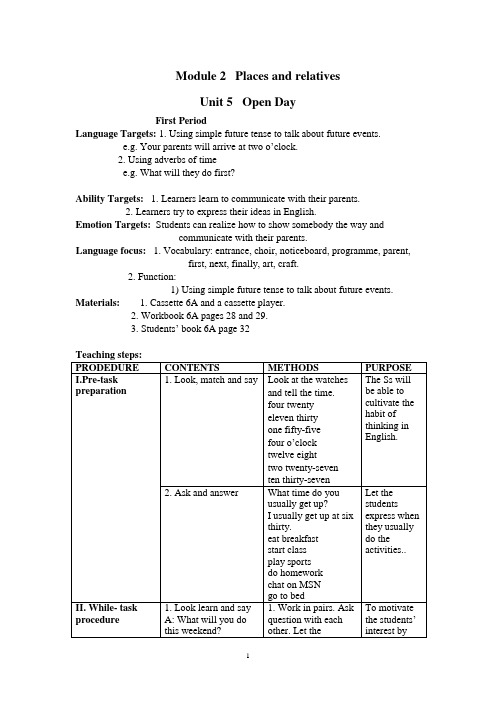
Module 2 Places and relativesUnit 5 Open DayFirst PeriodLanguage Targets: 1. Using simple future tense to talk about future events.e.g. Your parents will arrive at two o’clock.2. Using adverbs of timee.g. What will they do first?Ability Targets: 1. Learners learn to communicate with their parents.2. Learners try to express their ideas in English.Emotion Targets: Students can realize how to show somebody the way andcommunicate with their parents.Language focus: 1. Vocabulary: entrance, choir, noticeboard, programme, parent,first, next, finally, art, craft.2. Function:1) Using simple future tense to talk about future events. Materials: 1. Cassette 6A and a cassette player.2. Workbook 6A pages 28 and 29.3. Students’ book 6A page 32Second PeriodLanguage Targets: 1. Using the simple future tense to talk about future eventse.g. I’ll be in classroom 6AAbility Targets: 1. Learners learn to cooperate with each other.2. Learners try to express their ideas in English.Emotion Targets: Students will welcome their parents on the Open Day. Thisactivity will make them communicate with each other. Language focus: 1. New words: the ground floor, the first floor, the second floor,the third floor, gym, different.2. Function:1) Using the simple future tense to talk about future events. Materials: 1. Cassette 6A and a cassette player2. Students’ book 6A page 333. Workbook 6A pages 31.Third PeriodLanguage Targets: 1. Using the simple future tense to talk about future events.e.g. What will our parents do first?2. Using formulaic expressions to begin and end a letter.e.g. Dear …; YoursAbility Targets: 1. Learn to write an invitation.2. Learners try to express their ideas in English.Emotion Targets: Students can learn to express their ideas through the letter.Language focus: 1. Vocabulary: invitation, date, receive2. Function:1) Using the simple future tense to talk about future events.e.g. What will our parents do first?Materials: 1. Cassette 6A and a cassette player2. Students’ book 6A page 343. Workbook 6A pages 32 and 34.Fourth PeriodLanguage Targets: 1. Using the simple past tense to talk about past activities.e.g. The parents arrived at Rose Garden School at two o’clock. Ability Targets: 1. Identify details that support a main idea.2. Learners try to express their ideas in English.Emotion Targets: Students learn to communicate with their parents. Language focus: 1. Vocabulary: arrive-arrived, visit-visited, look-looked, listen-listened, have-had2. Function:1) Using the simple past tense to talk about past activities. Materials: 1. Cassette 6A and a cassette player.2. Students’ book 6A page 35内容总结11。
牛津版英语A完整教学说课优选稿

Pleaseintroduceyourself.
1.Singthesong
2.Saytherhyme
/Abook,apencil/
3.Sayordosomethingtheteacherasks.
Establishahappylearningatmosphere
e.g.,Touchyour…
emodeledsentencestocommunicatewithotherstudents.
ingimperativestogivesimpleinstructions.
e.g.,Touchyour…
Languagefocus
Teachingaids
Strengthenthenewwords
Usemodeledsentencestocommunicatewithotherstudents.
Post-taskactivity
1.Myfeeling
2.Myattitude
板
书
设
计
Jack
Thisismyface.
Thisismymouth.
Thisismynose.
Teachingaids
multimedia,sticks,etc.
Procedures
Step
Teacher’sactivities
Students’activities
Purpose
Pre-taskpreparation
1.Song/Goodmorning/
2.Arhyme
3.Dailytalk
Icansee.
T:Abook,apencil.
中西方文化的不同中英文对照

The Differences between Chinese and
western Culture
Diet
For one thing, Chinese and Westerners are different concepts in the diet. Chinese people are focus on the taste. They pursue all the Color, flavor and taste. But Western concept of rational diet. They pursue nutrition and they absorb Calorie and protein .Chinese people choice food very carefully. They only use fresh material in order to make delicious food. Western country like English or American, they don't have fresh food because they buy their food from supermarket which only sells stored materials. Chinese have a lot of ideas and techniques for cooking. For example, We can cook a chicken in over ten ways and people can taste all them with relish. Western people do not have many skills for cooking, mostly they only boil, steam and bake the food.
运用词串(lexical bundles )进行汉语词汇教学
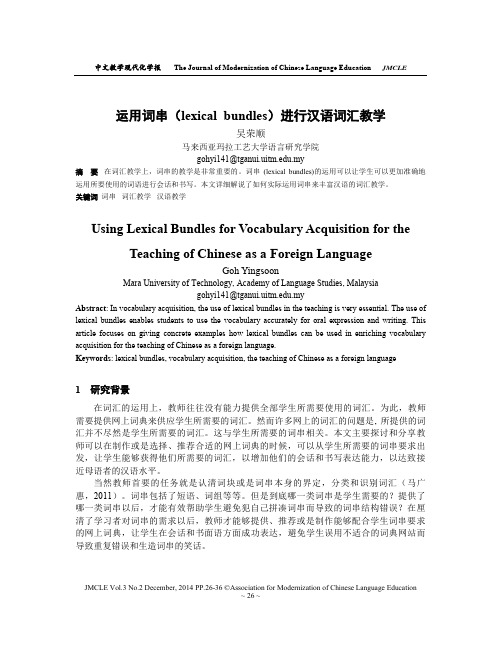
运用词串(lexical bundles)进行汉语词汇教学吴荣顺马来西亚玛拉工艺大学语言研究学院gohyi141@.my摘要在词汇教学上,词串的教学是非常重要的。
词串(lexical bundles)的运用可以让学生可以更加准确地运用所要使用的词语进行会话和书写。
本文详细解说了如何实际运用词串来丰富汉语的词汇教学。
关键词词串词汇教学汉语教学Using Lexical Bundles for Vocabulary Acquisition for the Teaching of Chinese as a Foreign LanguageGoh YingsoonMara University of Technology, Academy of Language Studies, Malaysiagohyi141@.myAbstract: In vocabulary acquisition, the use of lexical bundles in the teaching is very essential. The use of lexical bundles enables students to use the vocabulary accurately for oral expression and writing. This article focuses on giving concrete examples how lexical bundles can be used in enriching vocabulary acquisition for the teaching of Chinese as a foreign language.Keywords: lexical bundles, vocabulary acquisition, the teaching of Chinese as a foreign language1研究背景在词汇的运用上,教师往往没有能力提供全部学生所需要使用的词汇。
(新沪教牛津版)二年级英语上册《Module 3 Unit 3 第三课时》优质教案设计
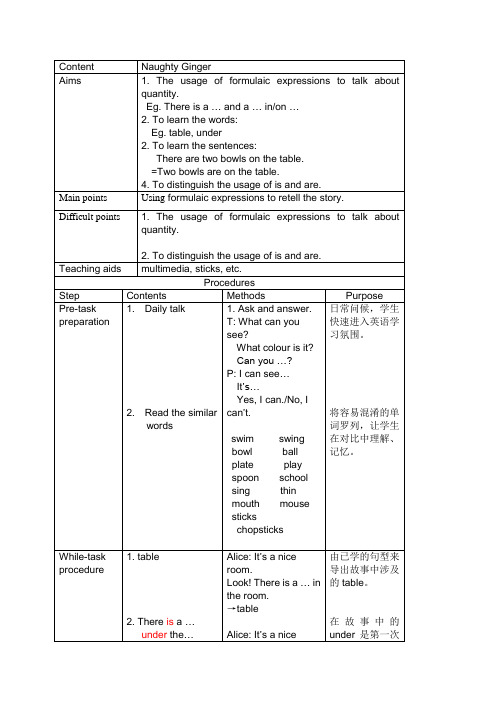
Step
Contents
Methods
Purpose
Pre-task
1. Daily talk
preparation
1. Ask and answer. T: What can you see?
日常问候,学生 快速进入英语学 习氛围。
What colour is it?
Can you …?
P: I can see…
elephant, egg ,five , fish….(More words)
Review the phrases about “ an”.
熟悉的单词引 入字母发音的 教学,有利于 学生对字母发 音建立起联 系,便于记忆。
e.g. an elephant ,an egg, an apple, an orange…
Naughty Ginger Yes, please. No, thanks. I have…with…
(建议从目标反思、过程反思、效果反思、改进意见等方面反思) 教 学 反 思
Period 3
Title
Say and act Learn the letters Language aims:
Aims
开展调查活动 能帮助学生在
WorkbookP10-1 3
s
2.Read and choose 3. WorkbookP13 Do a survey
真实的任务驱 使下运用英语 交际获取真实 的相关信息, 老师要指导学 生调查更具有 条理和秩序。
Assignm Homework ent
1. Listen to the tape and repeat P10-13.
While-task procedure
Lecture16虚拟时态

be- 型虚拟式 P.181
be-型虚拟式用动词原形表示,即不管主语是什么人称, 动词一律用原形。 它只有在单数第三人称主语之后才 是有标记的。用于:
1) 表示命令、决定、建议、主张、紧要等概念的词语. 由于它们本身隐含说话人的主观意见, 认为某事应该或 不应该怎样,固其后的 that- 分句用虚拟。
be- 型虚拟式
2) 用于由 if, though, whatever, lest, so long as 引导的分 句中表示推测、让步、防备等含义: P.182 1. Though everyone desert you, I will not. 2. Though he be the President himself, he shall hear us. 3. Whatever be his defense, we cannot tolerate this disloyalty. 4. So long as a volume hold together, I am not disturbed as to its outer appearance. 5. Whether she be right or wrong, she will have my unswerving support. 6. Quietly we sat on the river bank lest the fish swim away.
1. Your advice that she wait till next week is reasonable. 2. His sole requirement was that the system work. 他的唯一要求是该系统要发挥作用。 3. We were forced with the demand that this tax be abolished.我们面临着取消此项税收的要求。
牛津版小学英语1B教案 Unit 7 Birthday party
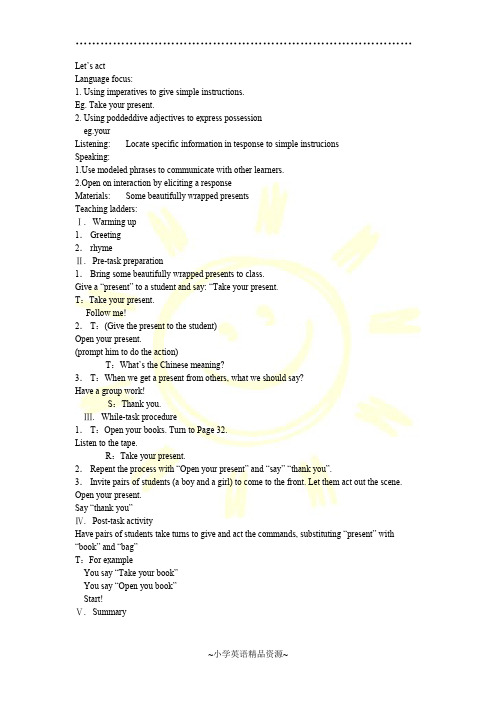
Language focus:1. Using imperatives to give simple instructions.Eg. Take your present.2. Using poddeddive adjectives to express possessioneg.yourListening: Locate specific information in tesponse to simple instrucionsSpeaking:e modeled phrases to communicate with other learners.2.Open on interaction by eliciting a responseMaterials: Some beautifully wrapped presentsTeaching ladders:Ⅰ. Warming up1. Greeting2. rhymeⅡ. Pre-task preparation1. Bring some beautifully wrapped presents to class.Give a “present” to a student and say: “Take your present.T:Take your present.Follow me!2. T:(Give the present to the student)Open your present.(prompt him to do the action)T:What’s the Chinese meaning?3. T:When we get a present from others, what we should say?Have a group work!S:Thank you.Ⅲ. While-task procedure1. T:Open your books. Turn to Page 32.Listen to the tape.R:Take your present.2.Repent the process with “Open your present” and “say” “thank you”.3. Invite pairs of students (a boy and a girl) to come to the front. Let them act out the scene. Open your present.Say “thank you”Ⅳ. Post-task activityHave pairs of students take turns to give and act the commands, substituting “present” with “book” and “bag”T:For exampleYou say “Take your book”You say “Open you book”Start!Ⅴ. SummaryLanguage focus:1. Using formulaic expressions to wish others a happy birthday.Eg. Happy birthday, Sam.2. Using nouns to indicate food and drinks.Eg. Cake, cake.Speaking: Use modeled phrases to communicate with other learners.Materials: 1. Wallcharts 1B2. Photos of a student’s birthday party.3. Some food and presents.Teaching ladders:Ⅰ. Warming up1. Greeting2. Train!Take your presentOpen your presentSay “thank you”Ⅱ. Pre-task preparationShow photos of a student’s birthday party.T:Look, XX is happy because it is his birthday. Your birthday is the day you were born. Birthday come only noce a year. My birthday is in (month). When is your birthday? (Ask several students to answer.)T:birthdayFollow me!Ⅲ、While-task procedure1. Put up the wallchrt. (for 30 senconds)Take it dowmT:What do you see?(apple orange, present)2. T:(Put the wallchact up)Sam has many present.They have many food.3.Introduce the items “cake” “ice-cream” “jelly” “sweet” “milk” and “coke” orally only in this lesson.To in troduce “ice-cream” you can ask what other sweet things you can eat at birthday s.4. T:(Point to the words)Happy birthday Sam.5. T:Llisten to the tape.Ⅳ、Post-task activities1. Bring some food and presents to class and put them on a table.Ask some students to sit at the table.2. Point to one of the students sitting at the table.T:Today is Sam’s birthday.What should we say to him them?Ⅴ、Consolidation.Workbook P22Let’s learnLanguage focus: Using nonns to identify food and drirfer.eg. Cake, milkListening: Locate specific information inresponse to simple instructions Speaking: Open an interacting by elicting a responsePronounce word properlyMaterials: Picture Cards 1BTeaching ladders:Ⅰ、Warming up1. Greeting2. Train:Take your predentOpen your present.Say “thank you”Ⅱ、Pre-task preparation1. Revise the food and drink namesT:cake, sweetice-cream yeallymilk coke2. Play a game.What is he eating?One mire eating food.The ters guessThe first one to guess correctly gok to come up and mire3. T:Do you like cakes?Sweets?Ice-cream?Jelly?Mike?Coke?Ⅲ、While-task procedure1. T:Let’s stick the pictures.Eg: T:coke.The students select one the pione the stick on the blackboard.2. T:Listen to the tapeListen & Read.Ⅳ、Post-task activityFind the friends.(The words & the rctres)Ⅴ、Consolidation.Let’s playLanguage focus: Using the werb “like” to indicate preperencesEg. I like cakesSpeaking: Maintain an intcraction by providing informationMatesials: Word and picture cards 1BTeaching ladders:Ⅰ. Warming up1. Greeting2. TrainTake your poesirtOpen your present.Say “thank you”Ⅱ. Pre-task preparation1. Put uo the cardsT:Read it one by oneCake, ice-cream, jellySweet, milk2. Hold up an apple, smff it mb it, look at is, lick your lipsT:I like apples. Yummy yvmmyT:Do you like apples?S:I like apple(Dick hap)Ⅲ、While-task procedure1. Put all the fond and drink picture eards on yours desk.T:I like ……(Enconage student to follow)2. Repew step1 with the other items.3. Stick the paper cut-out of may on the board.T:Hello, I am may. I like …… cake.4. Continuw telling the story by using other paper cut-outs of characters and food item. Eg may cakeSam ice-creamJellysweets5. Turn to page 15T:Listen to the tape6. T:Who can tell the story.Ⅳ、Post-task activities1. In group of five, students practise aetiang out the story.S:I like cakes.S:I like ice-cream.S:I like jellyS:I like sweetsS ->Look at kittyT:I like milk.2. Select group to act heir rele-plays to the classLet’s enjoyLanguage focus: Using formulaic expressions to wish others a happy birthday. Eg. Happy birthday, sam.Listening: Identify key words in an utterance by recognizing stress Speaking: Use modeled phrases to communicate with other learners Materials: Wallchart 1BTeaching ladders:Ⅰ. Warming up1. Greeting2. Train I like the present.I like the cake.I like the jelly.Ⅱ. Pre-task preparation1. Put up the wallchart.T:Do you remember what to say to Sam on his birthday?T & S:Happy birthday, Sam.2. T:It’s not enongh just to say it.We must sing the birthday song as well.Ⅲ. While-task procedure1. T:Open the books to Page 36.Listen to the song2. Play the cassatte again.Then sing the song for the class with some aotions.3. Do group work.Ⅳ. Post-task activities1.Very the song to “Happy New Year”Happy New Year to you.Happy New Year to you.Happy New Year, Dear Sam.Happy New Year to you2. Have the while class sing together.。
广东版开心英语三上《Unit1Hello》word教案
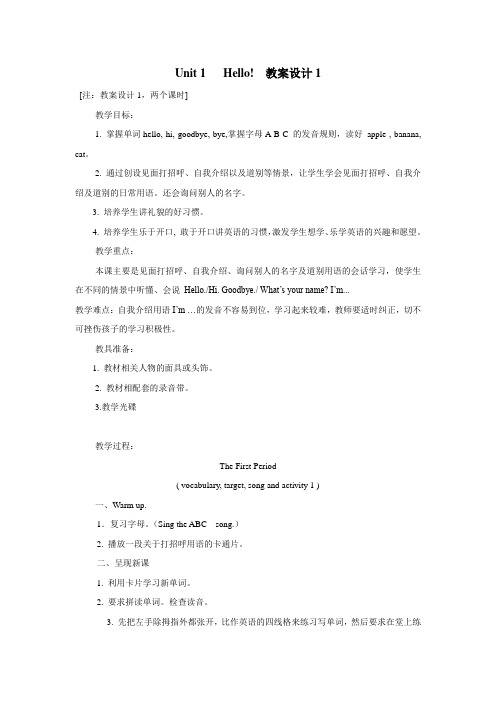
Unit 1 Hello!教案设计1[注:教案设计1,两个课时]教学目标:1. 掌握单词hello, hi, goodbye, bye,掌握字母A B C 的发音规则,读好apple , banana, cat。
2. 通过创设见面打招呼、自我介绍以及道别等情景,让学生学会见面打招呼、自我介绍及道别的日常用语。
还会询问别人的名字。
3. 培养学生讲礼貌的好习惯。
4. 培养学生乐于开口, 敢于开口讲英语的习惯,激发学生想学、乐学英语的兴趣和愿望。
教学重点:本课主要是见面打招呼、自我介绍、询问别人的名字及道别用语的会话学习,使学生在不同的情景中听懂、会说Hello./Hi. Goodbye./ What’s your name? I’m...教学难点:自我介绍用语I’m …的发音不容易到位,学习起来较难,教师要适时纠正,切不可挫伤孩子的学习积极性。
教具准备:1. 教材相关人物的面具或头饰。
2. 教材相配套的录音带。
3.教学光碟教学过程:The First Period( vocabulary, target, song and activity 1 )一、Warm up.1.复习字母。
(Sing the ABC song.)2. 播放一段关于打招呼用语的卡通片。
二、呈现新课1. 利用卡片学习新单词。
2. 要求拼读单词。
检查读音。
3. 先把左手除拇指外都张开,比作英语的四线格来练习写单词,然后要求在堂上练习本上练习写一次。
4. 通过肢体语言与对话进一步巩固单词。
5. 利用头饰来教句子:What’s your name? I’m... 戴上Tony 的头饰说: I’m Tony.What’s your name? 引导学生回答:I’m…(说自己的名字) 并引出Nice to meet you .6. 老师先示范与学生对话。
如: T: Hello!S: Hi! (Hello!)T: I’m Miss T an.What’s your name?S: I’m…T: Nice to meet you!S: Nice to meet you, too! (教师要引导)T:Goodbye!S: Goodbye!7. 要求学生与同桌对话。
英语作文考试情况分析范文初中
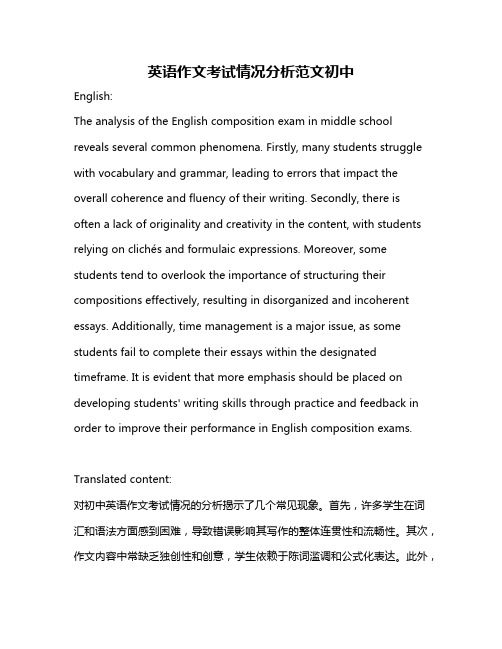
英语作文考试情况分析范文初中English:The analysis of the English composition exam in middle school reveals several common phenomena. Firstly, many students struggle with vocabulary and grammar, leading to errors that impact the overall coherence and fluency of their writing. Secondly, there is often a lack of originality and creativity in the content, with students relying on clichés and formulaic expressions. Moreover, some students tend to overlook the importance of structuring their compositions effectively, resulting in disorganized and incoherent essays. Additionally, time management is a major issue, as some students fail to complete their essays within the designated timeframe. It is evident that more emphasis should be placed on developing students' writing skills through practice and feedback in order to improve their performance in English composition exams.Translated content:对初中英语作文考试情况的分析揭示了几个常见现象。
上海版牛津英语AMU
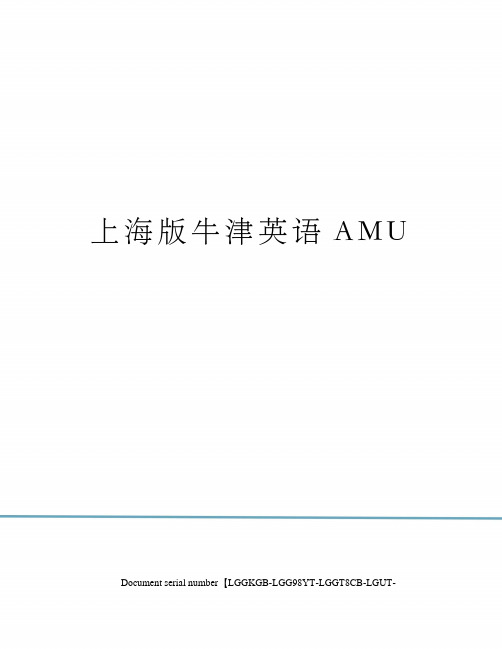
上海版牛津英语A M U Document serial number【LGGKGB-LGG98YT-LGGT8CB-LGUT-8A Module 1 My LifeUnit 3 TroubleThe First Period ReadingLanguage Targets:the simple past tense to write a diary.the adverbs of frequency to describe the action..formulaic expressions to organize a diary.can know how to help others in an indirect way.Language focus:1. Vocabulary:1) deal, trouble, argument, crowd, steal, hurry, afraid, ever,unusual, purse, quietly2) deal with, wait for, shout at, move through the crowd, stare at,hurry aboard, happen to, hold out, be going on2. Function: They stole my friend’s purse five minutes ago. Teaching aids:1. A recorder, a cassette2. S tudent’s book 8A page 39.Teaching steps:Second Period Grammar ALanguage Targets:1. Practise the simple past tense and adverbial expression.2. Students can use the simple past tense correctly.Language focus:1. Vocabulary: jump over a stream, blow down your tents, carry guns2. Forms of the simple past tense of irregular verbs.Teaching aids:1. A recorder, a cassette,2. Students’ book 8A page 42Teaching steps:Third Period Grammar BLanguage Targets:1.To use the adverbial phrases of time with the simple past tense toshow when something happened.2.Students can use the simple past tense correctly.Language focus:1. Vocabulary: jump over a stream, blow down your tents, carry guns2. Forms of the simple past tense of irregular verbs.Teaching aids:1. A recorder, a cassette,2. Students’ book 8A page 43Teaching steps:Fourth Period ListeningLanguage Targets:1. To learn to catch the main information you need while listening. describe a person’s appearance correctly.Language focus:: description, rather, baseball2. Functions: It was black and brown in color..He had quite long hair.Teaching aids:1. A recorder, a cassette,2. Students’ book 8A page 45Teaching steps:The Fifth Period SpeakingLanguage Targets:1. Learn three pronunciations related to the past tense forms of verbs.2. Be able to say the sentences with correct intonation .3. Introduce a historical figure usinthe grammar learnt in this unit.Language focus and difficult points:1. Three different ways of pronouncing the past tense forms of verbs.2. Vocabulary: mend downstairs India press the buttonTeaching Aids:1. Student’s Book 8A page 46.2. Multi-mediaThe Sixth Period WritingLanguage Targets:1. To finish Judy’s diary by using correct verbs and other words.2. To use the simple past tense to write a diary.3. To express their own ideas in English fluently.Language focus and difficult points:simple present tense.2. Vocabulary: helicopter, out of, up to, climb up Teaching Aids:1. Student’s Book 8A page 472. Multi-mediaThe Seventh Period More PracticeLanguage Targets:1. To learn some funny side of police work.2. To be able to collect information and find the imformation about funny side of police work.around you.express their ideas in English fluently.Language focus and difficult points:Vocabulary: admit, arrest, case, customs, rare, refund, release, smuggle, tellerTeaching Aids:1. Student’s Book 8A page482. Multi-media。
上海小学牛津英语1A一年级上册详细知识点
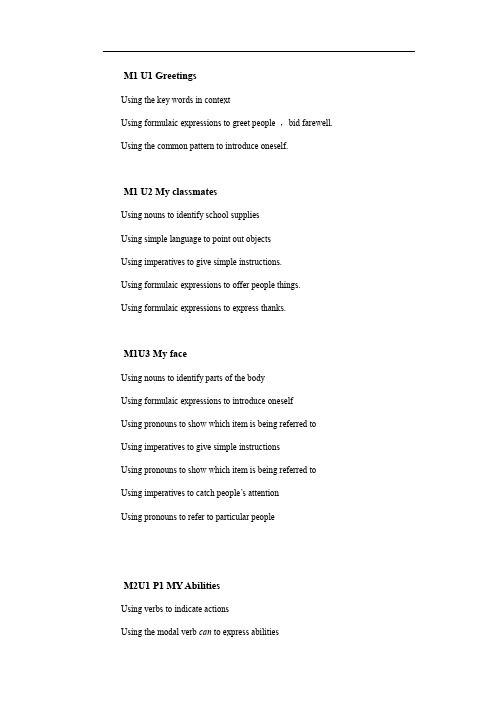
M1 U1 GreetingsUsing the key words in contextUsing formulaic expressions to greet people ,bid farewell. Using the common pattern to introduce oneself.M1 U2 My classmatesUsing nouns to identify school suppliesUsing simple language to point out objectsUsing imperatives to give simple instructions.Using formulaic expressions to offer people things.Using formulaic expressions to express thanks.M1U3 My faceUsing nouns to identify parts of the bodyUsing formulaic expressions to introduce oneselfUsing pronouns to show which item is being referred to Using imperatives to give simple instructionsUsing pronouns to show which item is being referred to Using imperatives to catch people’s attentionUsing pronouns to refer to particular peopleM2U1 P1 MY AbilitiesUsing verbs to indicate actionsUsing the modal verb can to express abilitiesAsking wh-questions to find out a person’s ability. E.g., What can you do?Using verbs to indicate actions. E.g., I can sing.M2U2 My familyUsing pronouns to identify people. E.g., meUsing nouns to identify family members. E.g., mother, father, grandfather, grandmotherUsing nouns to identify family membersUsing possessive adjectives to express possessionAsking wh-questions to find out a person’s identityUsing pronouns to identify peopleUsing formulaic expressions to confirm or denyM2U3 My friendsUsing adjectives to describe people. E.g., thin, fat, tall, shortUsing pronouns to identify peopleUsing adjectives to describe peopleAsking wh-questions to find out a person’s identityUsing the modal verb can to express abilitiesM3U1 In the classroomUsing numerals to count from one to sixUsing numerals to show quantityUsing numerals to count from one to sixUsing numerals to show quantityAsking questions to find out quantity?M3U2 In the fruit shopUsing nouns to identify fruit.e.g., apple, pear, peach, orangeAsking questions to find out quantitye.g., How many..?Using formulaic expressions to request something.Using formulaic expressions to reply requestsUsing formulaic expressions to express thanksM3U3 In the restaurantUsing nouns to identify food.e.g., pizza, hamburger, cake, pieHear specific information in response to simple questions.e.g., Give me a hamburger, please. Here you are.Using formulaic expressions to request somethingUsing an indefinite article to refer to somethingUsing formulaic expressions to greet customersM4U1 On the farmUsing nouns to identify common farm animalsUsing some onomatopoeic words to imitate the sounds of the farm animalsUsing verbs to give instructionsUsing the key pattern to role-play as farm animalAsking wh-questions to find out specific information about something Using a pronoun to refer to somethingM4U2 In the zooUsing nouns to identify animalsUsing adjectives to describe things.Asking yes/no questions to obtain simple responses.e.g., Is this a bear?Using formulaic expressions to confirm or deny.e.g., Yes./No. It’s a panda.M4U3 In the parkUsing adjectives to identify colours.e.g., It’s red.Asking wh-questions to find out the colours of objects.e.g., what colour is it?Using adjectives to identify coloursUsing imperatives to give simple instructionsUsing onomatopoeic words to indicate animal soundsUsing adjectives to describe animalsAsking wh-questions to find out specific information about an animal.。
牛津版英语六年级下册教案 Unit 2 Numbers

利用挂图做图意描述,使学习比较直观,符合低年级学生的特点
通过问答,使每个学生都有简单交际、练习对话的机会。
。
通过动手画画做一个巩固,避免枯燥
[3]
Teacher’s activity
Ss’ activity
remarks
Pre-task
1. Learn how to say 1-6
3. Divide the class into six groups.Add on or take away objects but always keep the number within the range of 1 to 6.Have each group count a different kind of object.The quickest to call out the correct number will be the winner.
1. Do excerises of Student’s Book(Page 9)
2. Put the same number of objects on a table in front of the e a pointer to point and count with students.
Put their personal items on the desks
Learn the rhyme.
Act it and judge right or wrong.
Practise acting the story.
Substitute and act the dialogue.
Draw a picture and practise.
牛津上海版(深圳用)小学英语三年级上册全册教案
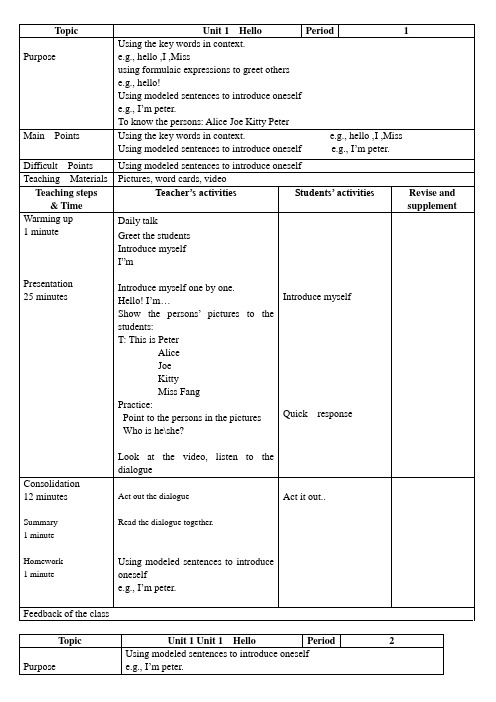
letter cards
Teaching steps& Time
Teacher’s activities
Students’ activities
Revise and supplement
Warming up
1 minute
Revision
2minutes
Presentation
T: This is Peter
Alice
Joe
Kitty
Miss Fang
Practice:
Point to the persons in the pictures
Who is he\she?
Look at the video, listen to the dialogue
Introduce myself
e.g., I’m peter.
Act it out..
Feedback of the class
Topic
Unit 1 Unit 1 Hello
Period
2
Purpose
Using modeled sentences to introduce oneself
e.g., I’m peter.
Learn to sing:
Teaching Materials
Pictures, video, letter cards
Teaching steps& Time
Teacher’s activities
Students’ activities
Revise and supplement
Warming up
1 minute
上海牛津英语3a教案
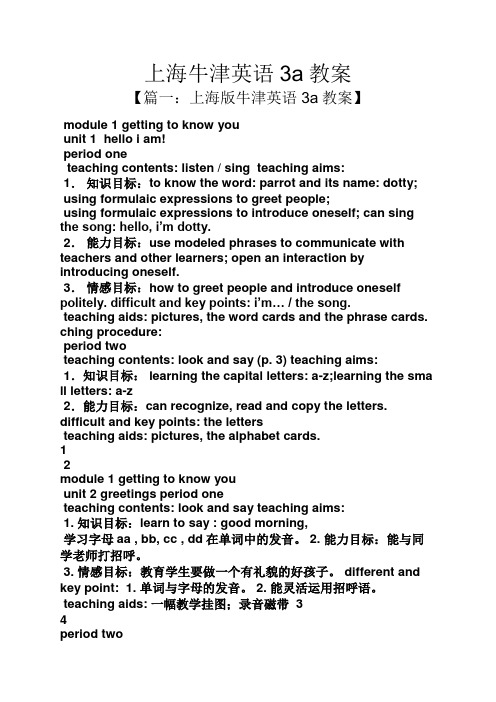
上海牛津英语3a教案【篇一:上海版牛津英语3a教案】module 1 getting to know youunit 1 hello i am!period oneteaching contents: listen / sing teaching aims:1.知识目标:to know the word: parrot and its name: dotty;using formulaic expressions to greet people;using formulaic expressions to introduce oneself; can sing the song: hello, i’m dotty.2.能力目标:use modeled phrases to communicate with teachers and other learners; open an interaction by introducing oneself.3.情感目标:how to greet people and introduce oneself politely. difficult and key points: i’m… / the song.teaching aids: pictures, the word cards and the phrase cards. ching procedure:period twoteaching contents: look and say (p. 3) teaching aims:1.知识目标: learning the capital letters: a-z;learning the sma ll letters: a-z2.能力目标:can recognize, read and copy the letters. difficult and key points: the lettersteaching aids: pictures, the alphabet cards.12module 1 getting to know youunit 2 greetings period oneteaching contents: look and say teaching aims:1. 知识目标:learn to say : good morning,学习字母aa , bb, cc , dd在单词中的发音。
有效教学的10条基本原则
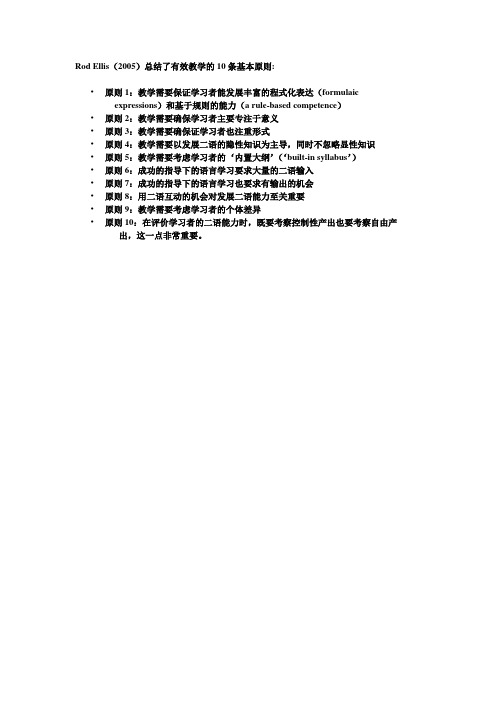
Rod Ellis(2005)总结了有效教学的10条基本原则:
•原则1:教学需要保证学习者能发展丰富的程式化表达(formulaic expressions)和基于规则的能力(a rule-based competence)•原则2:教学需要确保学习者主要专注于意义
•原则3:教学需要确保证学习者也注重形式
•原则4:教学需要以发展二语的隐性知识为主导,同时不忽略显性知识
•原则5:教学需要考虑学习者的‘内置大纲’(‘built-in syllabus’)
•原则6:成功的指导下的语言学习要求大量的二语输入
•原则7:成功的指导下的语言学习也要求有输出的机会
•原则8:用二语互动的机会对发展二语能力至关重要
•原则9:教学需要考虑学习者的个体差异
•原则10:在评价学习者的二语能力时,既要考察控制性产出也要考察自由产出,这一点非常重要。
剑桥三级分类词汇
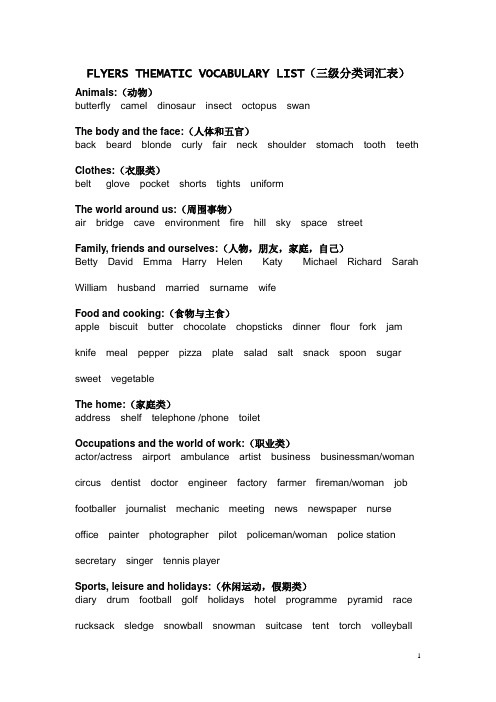
FLYERS THEMATIC VOCABULARY LIST(三级分类词汇表)Animals:(动物)butterfly camel dinosaur insect octopus swanThe body and the face:(人体和五官)back beard blonde curly fair neck shoulder stomach tooth teeth Clothes:(衣服类)belt glove pocket shorts tights uniformThe world around us:(周围事物)air bridge cave environment fire hill sky space streetFamily, friends and ourselves:(人物,朋友,家庭,自己)Betty David Emma Harry Helen Katy Michael Richard Sarah William husband married surname wifeFood and cooking:(食物与主食)apple biscuit butter chocolate chopsticks dinner flour fork jam knife meal pepper pizza plate salad salt snack spoon sugar sweet vegetableThe home:(家庭类)address shelf telephone /phone toiletOccupations and the world of work:(职业类)actor/actress airport ambulance artist business businessman/woman circus dentist doctor engineer factory farmer fireman/woman job footballer journalist mechanic meeting news newspaper nurse office painter photographer pilot policeman/woman police station secretary singer tennis playerSports, leisure and holidays:(休闲运动,假期类)diary drum football golf holidays hotel programme pyramid race rucksack sledge snowball snowman suitcase tent torch volleyballPlaces and directions:(地点和方向)airport bookshop bridge bus station caféchemist circus college club corner end get to left London museum over post office restaurant right station street theatre waySchool and education:(学校与教育)art bin club college competition dictionary exam(examination) glue Geography glue group History language Maths Science scissors shelf student subject universityTransport:(交通工具)ambulance taxi traffic motorbike helicopterWeather:(天气)fog foggy ice sky storm wind dry wet warm humid mild clear thundering rainy sunny hot cold windy nice rainbow weather Health:(健康类)doctor hospital ill medicine nurseColours and patterns: (颜色与式样)gold silver spot stripe black blue brown green grey(gray) pink purple red white yellow orangeMiscellaneous objects and other nouns: (各色各样的名词)brush card comb envelope flag key light(s) magazine money newspaper paper postcard present problem secret soap stamp swing tape recorder telephone torch umbrellaNumbers:(数字)Ordinals(序数词):21—1000Cardinals(基数词):11th—31stzeroQuantity and measuring:(数词类)a few a little a lot a piece of enough few half many much quarter The sense:(感官类动词)feel look smell taste touchMaterials:(材料)card glass gold metal paper plastic silver wood woolTime:(时间类)a.m. ago century date early future half hour last late later midday midnight minute month o’clock p.m. time tomorrow tonight The year:(年份,月份)January February March April May June July August September October November December Christmas Easter yearspring summer autumn winterFormulaic expressions:(套话用语)Excellent! Of course (not)!Adjectives:(形容词)best better boring cheap clever closed dangerous dark dear dry empty enough expensive extinct fast few friendly full (of) gold hard heavy high horrible important interesting kind last late left light little lovely low many married metal next nice noisy other poor ready rich round same silver single slow soft strangesure tidy warm worse worstPrepositions:(介词)across during far for from into near past since through until without on in under in front of behind beside/next to between Adverbs:(副词)ago all right already also anywhere away everywhere far fasthard just later near nowhere of course(not) once only perhaps so somewhere soon still suddenly together too twice usually yet Pronouns:(代词)anyone anything each else enough everybody everything nobody someone somebody I we you he she it they my our your his her its their me us you him her it them Conjunctions:(连词)if and because so but forVerbs:(动词)Irregular: (不规则动词)begin break bring cut fall feel(like) forget get off get on get to go out have to hear let lie down lose make may meet saysell send smell speak steal swing teach winRegular:(规则动词)agree arrive ask for believe brush burn camp comb decide explain fetch finish follow glue happen hate look at look for look like mind post prefer pull push race remember skisledge sound(like) stay study taste(like) thank tidy turn offturn on use visit whisper whistle wishDeterminers:(定冠词)a/an the this that these thoseContainers:(容器类)bottle(of) bowl(of) cup(of) glass(of)。
英语作文现象阐述型
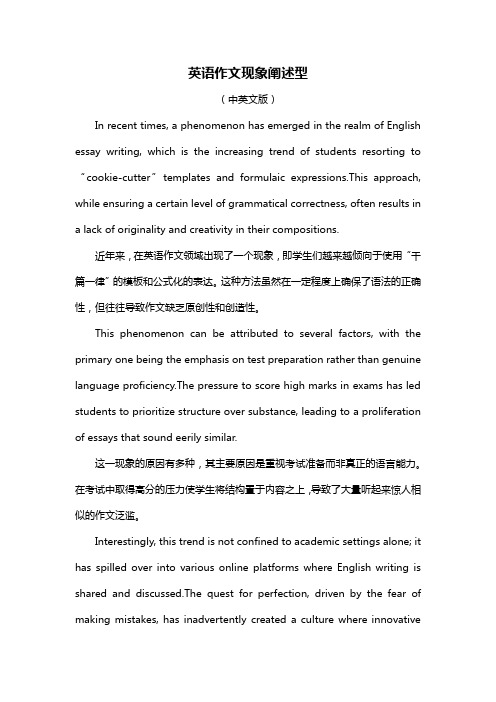
英语作文现象阐述型(中英文版)In recent times, a phenomenon has emerged in the realm of English essay writing, which is the increasing trend of students resorting to “cookie-cutter”templates and formulaic expressions.This approach, while ensuring a certain level of grammatical correctness, often results in a lack of originality and creativity in their compositions.近年来,在英语作文领域出现了一个现象,即学生们越来越倾向于使用“千篇一律”的模板和公式化的表达。
这种方法虽然在一定程度上确保了语法的正确性,但往往导致作文缺乏原创性和创造性。
This phenomenon can be attributed to several factors, with the primary one being the emphasis on test preparation rather than genuine language proficiency.The pressure to score high marks in exams has led students to prioritize structure over substance, leading to a proliferation of essays that sound eerily similar.这一现象的原因有多种,其主要原因是重视考试准备而非真正的语言能力。
在考试中取得高分的压力使学生将结构置于内容之上,导致了大量听起来惊人相似的作文泛滥。
沪教版小学一年级英语教案三篇
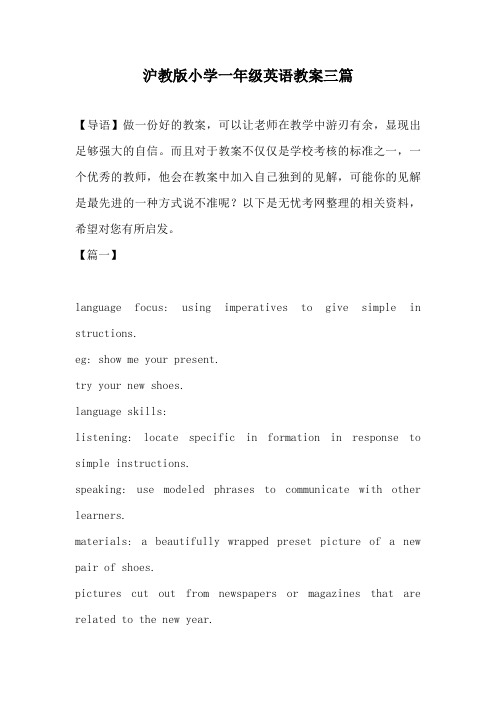
沪教版小学一年级英语教案三篇【导语】做一份好的教案,可以让老师在教学中游刃有余,显现出足够强大的自信。
而且对于教案不仅仅是学校考核的标准之一,一个优秀的教师,他会在教案中加入自己独到的见解,可能你的见解是最先进的一种方式说不准呢?以下是无忧考网整理的相关资料,希望对您有所启发。
【篇一】language focus: using imperatives to give simple in structions.eg: show me your present.try your new shoes.language skills:listening: locate specific in formation in response to simple instructions.speaking: use modeled phrases to communicate with other learners.materials: a beautifully wrapped preset picture of a new pair of shoes.pictures cut out from newspapers or magazines that are related to the new year.a large sheet of card which has the actline of a lantern on it.teaching ladders:��. warming up1. greeting《good morning》 song2. rhymet:let’s have a cutest.each group read a rhymeeg: one, two, threeread, sing, drawmy father is comingthis is my nose.��. teaching new lesson(一) pre-task preparation (中英文对应)1. t:the new year is near.whether your parents are going to buy you new clothes or shoes?s:yea.t:whether you will re cavies’ presets from your relatives. s:yes.2. t:(point to the shoes)look, my shoes are old.i need new shoes for the new year.(still pointing)t:shoes.t:(point to a student’s shoes)shoesencourage the class to point to their own shoes.t:read: shoes3. t:(show a beautifully wrapped present)what is it?t:present. it is a presart.t:present /present/ (slowly)follow me.present.4. t:(open the present & take out a picture of a new pair of shoes)new shoes.编儿歌 shoes . new shoes.��. while―task procedure1. play the cassette tape.listen to the instructions:“show me your present”“try your new shoes”2. open the book to page 2(1) play the tape, ask the strdats to act out the scere.(2) read the commands for the class to follow.3. give commentst:each group repents & acts them.��. post―task activitybring in pictures cut out from newspapers.which are to do with the new year.give stadarts a large sheet of card on which you have drawn the outline of lanterns.invite undivided to give the pictured inside the lantern. let’s talklanguage focus:1. using formulaic expressions to greet peopleeg: happy new year!2. using formulaic expressing to ask how some one is, and respondingeg. how are you?i’m fine, thank you.language skills:speaking: use modeled praises to commuaicate with theteacher & the other leaners.open an interaction by greeting someone politely. materials: pictures of or real things liked to chinese new year such as red packets, fire crackwe, cte.teaching ladders:��. warming up1. greetinggood morningturen into four lines.2. rhymet:each group read a rhyme��. pre task-preparationt:show the picture of or real things linked to the chinese new year.出示图片(1) mid autmmin festivel(2) what festival do these things make you think of(3) t:the spring festival new year.��. while―task procedure1. prt up the wall chart.t:dig doing.2. t:why did sam’s aunt & uncle come to visit them?what did they ask sam when they arrived.what did sam reply?what did may say to her grandfather & grandmother?3. t:how are you.s:fine, thank you.t:i am fire.4. t:happy new year!follor me.5. play the tape.practise in pairs.6. train(1) how are you.i am fine, thank you.(2) happy new year!��. post-task activity1. act out the scene2. pay attertion the thank you.��. consolidatiorwork book page 2: look, listen & respond.let’s learnlanguage focus: using nouns to identify relatins eg. grandfathergrandmotherauntlanguage skill:speaking: pronounce words proparly materials: word & picture cards 1b a vocabulary sheet for each student. teaching ladders:��. warming up, daily talk1. greetingwhat’s your name?how old are you?how are you?2. rhyme 出示图片t:point to your father.s:my father.t:have you got a bother?s:yes, i have got a bother.no, i have got a sisther.3. train(1) wordfather, mother, brother, sister (2) this is my father(3) have your got a brother?sister?yes, i have.no, i haven’t.��. pre-task preparation1. t:(greet individual students)how are you?s:i am fine, thank you.2. t:what can you say when you meet people during the new year.s:happy news year!��. while-task procedure1. put up the wallchait. (p3)t:who is this?t:uncle, aunt.grandfathergrandmotherrepeat.2. put the appropriate word cards under the four relatives on the wall chart as they said.eg:3. read the words: uncleauntgrandfathergrandmother4. open the book to p4play the tape & point to the correct person on the pages as they lister.5. scatter the picture & word cards for “uncle”“aunt”“grandfather”“grandmother”��. post―task activitygive each student a sheet of paper on which are written the four relatives’ names.draw them1.listen & tick the correct picture.2.glue the words beside the worrect picture.let’s playlanguage focus: 1. using imperatives to give in structions. eg. draw, writeing formulaic expressions to greet people during the new year.eg. happy new ywar, teacher.language skill:speaking: pronounce words proparlylistening: identify specific information in response to simple instructions.materials: the enlanges picture of page 5.some colour pens and a drawing card.some new year cards made by children.teaching ladders:��. warming up1. greeting2. a contestread phyme3. train: uncle, aunt, grandmother, grandfather��. pre-task preparation1. show the class some new year cardst:the cards are made by other students.2. t:do you like these cards?do you want to make are?��. while-task procedure1. put up the enlarged picture of student’s book page 5. introduce the steps of making a new year card.��. post-task activityget students to pretend that they are going shopping to buy a new item of clothing. they should work in groups of three, one being the shopkeeper, the other two the customers.��. consolidationworkbook page 4l trace the line and say who has what.l draw lines to show who likes what.【篇二】Learning skills:Students can sing and act the song freely.Students know the word: littleLearning materials:Tape recorder, cards, a paper rabbit, ...Learning course:Pre-task preparation:1. Free talk.How are you?How old are you?I see a ...What can you see?Happy New Year!2. You did a good job. Now let’s listen and act, ok?Show me your ...Clap one, clap two...While-task procedure:1. Can you count from one to ten? Let the students count from one to ten.2. Teacher acts a bird, a rabbit. Then draw a big rabbit on the blackboard, point and say a big rabbit. Then draw a little rabbit, ask the students:“is it big? No, it‘s a little rabbit. Repeat a little rabbit for several times. Today will learn a song about the little rabbit.ok?3. let the students sing the song follow the teacher sentence by sentence, then paragraph by paragraph with the actions.4. Play the tape and get the students listen carefully,then teacher act and sing the song with the students.Post-task activities:1. Let the students sing the song with actions together.2. Have a competition within the groups. To see which group is the best one.Consolidation:1. Sing the song with actions together.2. invite some students to sing.【篇三】1、能听说、认读yellow、red、green、blue、brown这些表示颜色的单词,发音正确。
- 1、下载文档前请自行甄别文档内容的完整性,平台不提供额外的编辑、内容补充、找答案等附加服务。
- 2、"仅部分预览"的文档,不可在线预览部分如存在完整性等问题,可反馈申请退款(可完整预览的文档不适用该条件!)。
- 3、如文档侵犯您的权益,请联系客服反馈,我们会尽快为您处理(人工客服工作时间:9:00-18:30)。
Admitting you’re wrong
Yes, I hadn’t thought of that. Yes, perhaps you have a point there. Sorry, I got it all wrong. Yes, I’m afraid I did miscalculate.
Compliments
I do think that’s charming. I wish I could keep looking as young as you. I admire the way you speak to your students. The subtlety of color is absolutely unbelievable. My compliments on your memory. Your composition has improved tremendously.
THE MOST POPULAR SENTENCES (3)
15. I couldn’t get through. 16. I won’t be long. 17. You can say that again. 18. I’m sorry to hear that. 19. Don’t beat around the bush. 20. That’s the way it goes.
Expressing delight
How wonderful! Fantastic/Great/Terrific/ Smashing/Marvelous/Super! I’m very pleased to hear the news. It gives me great pleasure to hear that.
All right, thank you. Can’t complain. Not too bad, thanks. Could be beteat!
Agreeing Partially
If you say so. Yes, up to a point, but don’t you think… I see what you mean, but … That’s all very well, but, on the other hand, … To a certain extent, yes, but… Could be/yes, but…
Apologizing
I can’t tell you how sorry I am. I’m afraid I’ve brought you too much trouble. I’m so sorry, it was all my fault. I do beg your pardon. Please forgive my forgetfulness.
Responding to thanks
You’re welcome. My pleasure. Thank you (I want to thank you, too.) Thank YOU(I should thank you instead.) I’m glad to have been of some service.
Agreeing Completely
How right you are! I think you are right there. Exactly. I can’t help thinking the same. I couldn’t agree more. I go along with you there. I agree entirely with your view. You can say that again. You said it.
Expressing thanks
Thank you very much indeed. Many thanks. I can never thank you enough for your generosity. I’m extremely grateful to you. It’s most thoughtful of you.
Disagreeing jokingly
Are you kidding? You must be joking. You can’t mean that. That’s ridiculous. No way.
Disagreeing seriously
Not really. That’s not how I see it. I don’t think you are right there. That’s your opinion, not mine. I think you are mistaken. I am not at all sure, actually. I can’t go along with your view.
Congratulating
Congratulations on winning the game. It was great to hear about your recent promotion. Allow me to offer my heartiest congratulations. I’d like to be the first to congratulate you.
Greeting someone
Hello/Hi! Morning/Evening How are you doing? How’s life? What’s new? Long time no see. Small world, isn’t it?
Responding to greetings
Disagreeing politely
I’m afraid I have a different opinion. I beg to differ with you on that matter. Personally, I tend to disagree with him. Well, I’m not convinced.
Responding to compliments
I’m very glad you think so. How very nice of you to say so. I’m just lucky. You look very well yourself, in fact. That’s very kind of you, but I owe it all to my friends who helped me so much.
Responding to apologies
Don’t let it worry you. It really isn’t worth mentioning. It’s not your fault. No harm done. Please don’t feel bad about it.
成语与套话 及言语功能标识
Idioms, Formulaic Expressions and Discourse Markers 张建理 编纂
THE MOST POPULAR SENTENCES (1)
1. 2. 3. 4. 5. 6. 7.
Sure. Go ahead. Congratulations. Amazing! delicious.! Pretty good. I’m broke. You’re kidding.
THE MOST POPULAR SENTENCES (2)
8. It really got to me. 9. I’ve no idea. 10. I’ll show you. 11. It’s a deal. 12. I envy you. 13. I have to run. 14. How are you doing?
